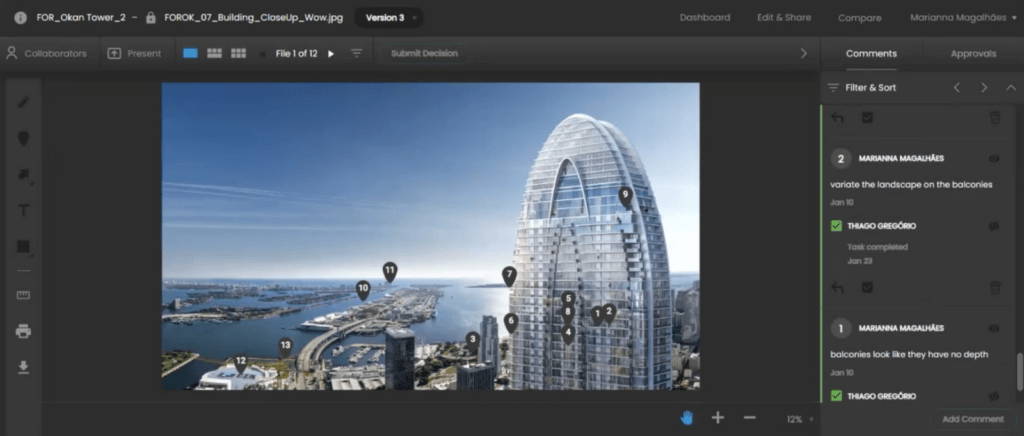Today’s creative agency needs to provide clients with the benefits of a full-service offering. While it’s possible to specialize in one small niche, the deeper your offering, the easier it is to scale up with clients that need a range of services.
For agency and client alike.
With that range in services comes the requirement to collaborate effectively, especially with clients, to deliver winning results at every touchpoint.
We spoke to Marianna Magalhães, managing director at Elephant Skin, about how they use ReviewStudio to significantly impact the way they develop projects, keeping on schedule – and budget.

Daniela: Elephant Skin is an agency focused on facilitating brand storytelling. As you say, “We are made of stories”. Can you tell us about Elephant Skin’s story?
Marianna: Elephant Skin was born to fill a gap in the real estate market between creating a project and selling the project. In the past, the focus was primarily on highlighting the physical attributes of a property, such as its location, size, and amenities. However, today, real estate developers recognize the power of storytelling in attracting and engaging potential buyers.
By telling a compelling story, real estate developers can engage potential buyers on an emotional level and create a desire to make a property their own. It’s all about creating a connection between the buyer and the property.
We like to say that we create WOW stories. We’re involved from the very beginning of the narrative development and deliver everything from concept, positioning, campaign strategy, and the delivery of assets. We present a unified story, telling a consistent and compelling narrative.
We have evolved into a renowned creative intelligence platform exclusively dedicated to real estate developments. Through brand storytelling, creative intelligence, marketing strategy, 3D renderings, film animation, interactive tours, and immersive presentations, we’ve transformed the way real estate projects are conceived and presented.
As someone with a project management background, what are some of the worst approaches to gathering feedback and approvals you’ve seen?
At a company I worked at early on in my career, they did reviews by leaving feedback on slide presentations. There were also emails, word documents, and spreadsheets.
Let’s say our projects usually have between 2 to 20 images, along with video and branding assets. If you’re simply doing a brochure you can have 10 to 20 assets per deliverable. Imagine receiving feedback on each one of those assets on a different platform.
I think the nightmare was having a lot of the feedback coming from different places.
It can be especially challenging with images when you want to change something specific. For example, you see a scene where you have a cup of coffee, and you want a bowl instead. How, in an email, do you pinpoint exactly what you want and where?
How does ReviewStudio fit into your production process in terms of involving your clients in the process?
Elephant Skin is fully remote. We have teams in Vancouver, the US, Europe, and Brazil. We also have clients worldwide.
We have a lot of stakeholders to deal with, including different providers for renderings, graphic design, film and so on. Sometimes the accounts team or the marketing specialists get caught in the middle.
We have many assets being developed on many fronts and timelines.
So, having ReviewStudio as a proofing platform for gathering feedback with clients in one place – where feedback is well documented – is such a great asset.
It’s easy to keep the client deeply involved in the entire process – to review, give feedback, share references, or leave their input directly on the images or videos.
When the creative process happens in siloes, the client can, at times, not understand fully how we are working through things, and feedback can be more extensive, with less clarity.
Are there any features that have been game changers for you?
We really like using versioning with a well-documented iterative process. If you are working on version 5 and someone wants to go back to version 2, it’s one click. And you can easily make comparisons.
With interior images, we often have many precise and minute changes in terms of furniture or finishings. Compare mode allows us to quickly see how much the image has changed from one version to another. We like to use it to show clients the work done within this process for accountability.

How has ReviewStudio changed the way you’re gathering feedback on real estate content from the clients?
When we present our process to clients, we also present ReviewStudio. Some are not aware of the platform. We introduce them to how they can make comments, attach documents, go between versions and other relevant features.
Overall, ReviewStudio is very intuitive – you can just send the link and people get how to leave their comments.
And the client feedback is very positive. There are some who are resistant since they’re used to sending feedback through email or in a document. Even when we receive feedback via email or PDFs, we just add it into our Review.
In terms of adoption, are there features your customers appreciate? Are they happy with the process?
It gets to the point in CGI development when the updates become very, very precise. When you send the image by itself – it’s so hard to compare between the old version because it’s going to look like it hasn’t changed at all. In ReviewStudio it’s very easy to compare.
Sometimes things slip through the cracks and someone mentions “comment 12” from a previous version that was not addressed. We can see specifically which comment and the reason. So that’s something that I think clients really like about the tool.
The centralized view of creative history and feedback provides accountability for everyone.
Lastly, we like the ability of having external users in ReviewStudio. Before this feature was launched, we had two different links – one for the client and one for our internal team. What is amazing is being able to send the same ReviewStudio link to the client and for our internal team.
We like everything in one centralized place.

On the subject of video, can you tell us a bit more about the benefits you are seeing in terms of collaboration? Do you see particular value created in your video production process?
Imagine that you spend a lot of time developing the videos and the animations, and then the client asks you to make a change… Well, for a video that’s 60 or 90 seconds long, it can be one to two days of work. It adds up.
When we develop video, we create a script, then we develop the key frames, and then we have the team of artists developing the scenes. So, for the feedback process for video, it’s important to have support for multiple formats, be able to navigate versions, and have precise comments.
First, we develop camera options. Let’s say that you are a developer from a real estate company and you have this huge building that you want to develop renderings for marketing purposes.
So you sent to us a list of images for a brochure:
- A terrace.
- The club room.
- Image of the pool.
- Image of the lobby.
Using PDF, we can add multiple options, so the client can go in and choose. They can add feedback such as “I want this camera angle to move forward”. They can make comments separately on each of the images.
We do a lot of revision rounds to make sure all the client’s comments are input – and we are aligned. When we have more precise feedback, we diminish a lot of rework.
With ReviewStudio we break down the process into phases, which helps a lot to limit complicated, time-intensive renderings.

Elephant Skin offers “creative, efficient, and intelligent” options for real estate marketing. How might you say ReviewStudio builds on that promise?
If you remove bureaucracy, you open up space for people to be creative.
In a Review, we have artists who are working from home on their own time. They have their tasks, and they have the library to create. They can post and get feedback. People have the time to be creative, because for someone working in Brazil who needs feedback from a colleague in Vancouver – they can easily collaborate. There’s no question of “Is this proofed?” “Am I going in the right direction?” etc. People don’t need to spend their time chasing feedback.
If you have a very concise, streamlined platform for people to add feedback, it helps people do their best work. It helps a lot with communication, especially us being an all-remote company because you can’t just go over to the desk beside you and ask the person
Do you think that technology (and in particular ReviewStudio) has enabled you and your team to tell better stories?
We are able to tell the stories because we have a precise and concise process. With ReviewStudio we have a proofing process that allows all of the artists and designers to better develop what they’re working on. Feedback is so important in our processes. Not only client comments but our internal comments, because we work in a very collaborative way.
When you have feedback, you have directions. And it’s not just any feedback – it’s getting quality feedback.
I think because of this feedback and accountability the work ends up being much more complete and the storytelling translates itself in the deliverables.
How has ReviewStudio contributed to your team’s productivity?
People can get lost in the creation and they forget that they need to deliver that at some point in time. We’re responsible for timelines, so we need to be productive.
We often have very tight timelines. We have launch dates and project investors. For a client that has an event, I can create the most beautiful thing, but if it’s not delivered by the time of the event, it’s not going to be shown.
Our schedule is something we take very seriously. Everything we can do to streamline our production, the better.
That said, we are never going to diminish our quality of delivering on time, so we try to do both. That’s where ReviewStudio makes us more productive.






